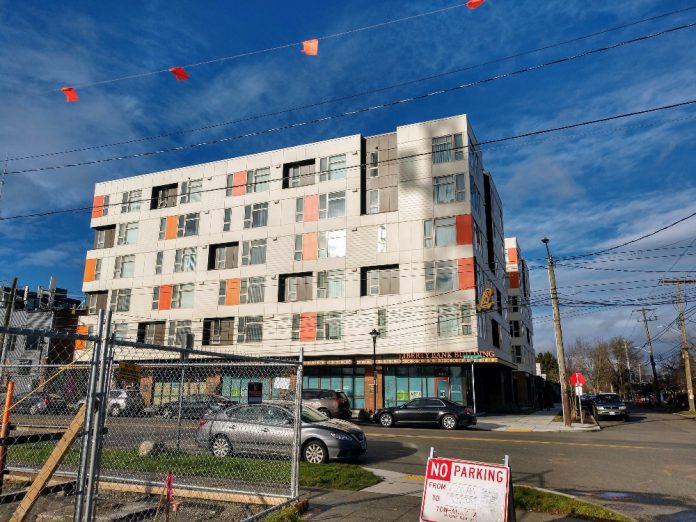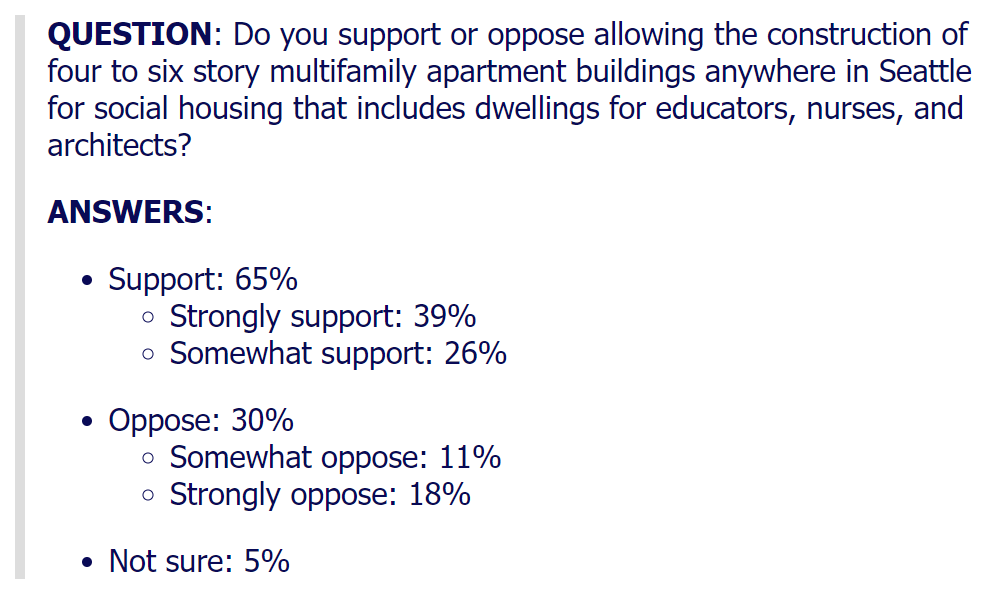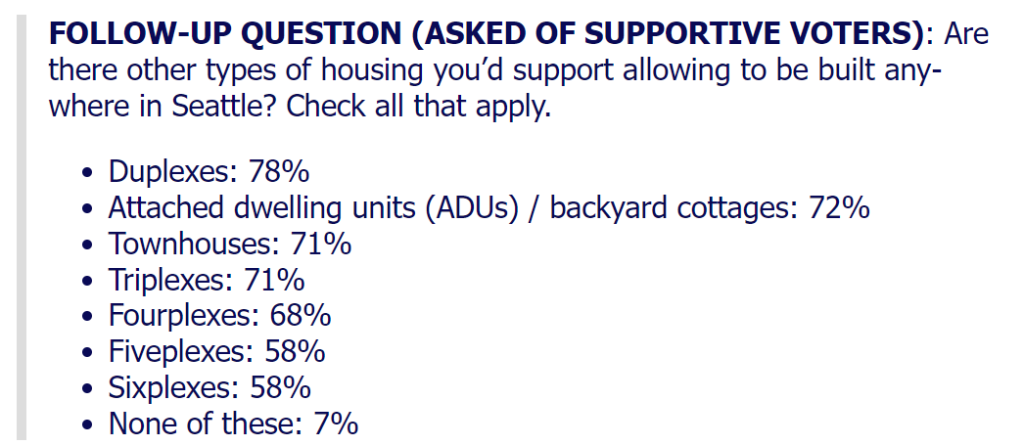
Social housing is popular in Seattle — so popular it even seems to override concerns about appropriate building scale and amorphous “neighborhood character.” To wit, 65% of respondents to a recent poll targeting high propensity Seattle voters support constructing four- to six-story apartment buildings “anywhere in Seattle” to expand social housing.
Northwest Progressive Institute (NPI) commissioned the poll of 651 likely special election voters, which was conduced by Change Research in February. NPI was seeking to gauge voter sentiment heading into the special election for Initiative 135, which establishes a public developer of social housing in Seattle. I-135 ended up passing handily with 57% of the vote, and the City is in the process of setting up the authority, which only has limited startup funding so far.

Meanwhile, the poll found support for fiveplexes and sixplexes (with no stated social housing mission) is weaker than for mid-rise social housing apartments — though a solid majority of 58% supported those larger multiplexes as well. Fourplexes were slightly more popular than midrise social housing at 68%, and duplexes were hugely supported at 78%. Townhomes and triplexes clocked in at 71% support.

The poll provides strong support for an all-of-the-above approach to adding housing all across Seattle, with the interesting twist that social housing developments appear to make larger buildings more popular than they’d otherwise be. More than two-thirds of Seattleites support market-rate fourplexes anywhere, but a similar share support four- to six-story apartment building geared toward the working class.
This revelation suggests zoning incentives that allow higher height limits and density caps for social housing would be effective in opening up new areas of Seattle to apartment development and garnering support for that change.
That information will be useful as the Harrell administration prepares its “One Seattle” Comprehensive Plan laying out a growth strategy for the next two decades. A Draft Environmental Impact Statement (DEIS) for that plan had been scheduled to released this month, but the Office of Planning and Community Development recently announced the DEIS release is being delayed to “early September.” A final comp plan must be passed by the end of 2024 under state law.
Real Change, The Urbanist, and pro-housing councilmembers including Teresa Mosqueda and Tammy Morales had pushed for the addition of a more aggressive Alternative 6 to the five alternatives in the existing plan and called for zoning incentives for affordable housing. Something like Alternative 6 could clear the way for more mid-rise social housing, although Alternative 5 also gets part of the way there. That Alternative 6 addition has not occurred thus far, as OPCD has stuck with the five alternatives in its current framework.
Social housing is often used as a catchall term for affordable housing set aside from the profit-driven private market. House Our Neighbors, the coalition that drafted I-135, further defined their brand of social housing as permanently affordable, publicly owned, and with tenant leadership of buildings. The initiative tasked the newly created public developer with delivering housing geared toward middle-income and low-income Seattleites up to 120% of area median income.
Thus, the newly established public developer will work toward providing affordable homes to educators, nurses, and architects mentioned in the poll question — whose income are often too high to qualify for nonprofit housing, but too low to comfortably afford high quality housing on the market. The coalition is seeking to create cross-class communities and is hoping for a cross-subsidy effect that may not just cover operating expenses but also allow a stream of revenue to invest in yet more social housing creation.
For now, the new public developer is counting on a major investment of public funds to start scaling up. Greater zoning capacity in more areas would also be helpful once the social housing authority is ready to build. Public opinion polling suggests Seattleites are already onboard with zoning changes to speed the way and allow a path to housing abundance.
For more on the poll, check out NPI’s post. Pollsters note “post-stratification” was performed on age, gender, race/ethnicity, zip code, and 2020 presidential vote to weight results for typical voting demographics. They report 61% of respondents were homeowners and say the poll has a modeled margin of error of 4.2%.
Doug Trumm is publisher of The Urbanist. An Urbanist writer since 2015, he dreams of pedestrian streets, bus lanes, and a mass-timber building spree to end our housing crisis. He graduated from the Evans School of Public Policy and Governance at the University of Washington in 2019. He lives in Seattle's Fremont neighborhood and loves to explore the city by foot and by bike.

